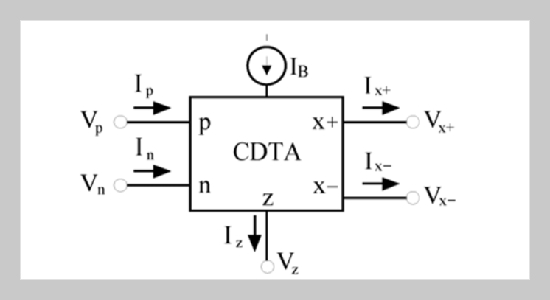REFERENCES
- [1] Bhattacharyya, B. B. and Darkani, M. T., “A Unified Approach to Realization of Canonic RC-Active, Single as well as Variable, Frequency Oscillators Using Operational Amplifiers,” Journal of Franklin Inst., Vol. 317, No. 6, pp. 413419 (1984). doi: 10.1016/ 0016-0032(84)90025-5
- [2] Gonzalez, G., Foundations of Oscillator Circuit Design, Artech House Publishers (2007).
- [3] Smith, K. C. and Sedra, A. S., “The Current Conveyor: A New Circuit Building Block,” Proc. IEEE, pp. 13681369 (1968). doi: 10.1109/PROC.1968.6591
- [4] Toumazou, C., Lidegy, F. J. and Haigh, D., Analog IC Design: The Current-Mode Approach, Peter Peregrinus Press, U.K. (1990). doi: 10.1049/PBCS002E
- [5] Lo, Y. K., Chien, H. C. and Chiu H. J., “Tunable Waveform Generators Using Single Dual-Current Output OTAs,” J. Circuits Syst. Comput, Vol. 17, No. 6, pp. 11931202 (2008). doi: 10.1142/S0218126609005393
- [6] Maheshwari, S. and Khan, I. A., “Novel Voltage-Mode Universal Filter Using Only Two CDBAs,” J. Circuits Syst. Comput, Vol. 14, No. 1, pp. 159164 (2005). doi: 10.1142/S0218126605002118
- [7] Sagbas, M. and Koksal, M., “Realization of a General Resistorless Active Biquad Using CBTA,” J. Circuits Syst. Comput, Vol. 21, No. 1 (2012). doi: 10.1142/ S0218126612500132
- [8] Mohan, J., Maheshwari, S. and Khan, I. A., “MixedMode Quadrature Oscillators Using Single FDCCII,” Journal of Active and Passive Electronic Devices, Vol. 2, No. 3, pp. 227234 (2007).
- [9] Liao, W. B. and Gu, J. C., “SIMO Type Universal Mixed-Mode Biquadratic Filter,” Indian Journal of Engineering and Material Sciences, Vol. 18, No. 6, pp. 443448 (2011).
- [10] Pandy, N. and Kumar, P., “Realization of Resistorless Wave Active Filter Using Differential Voltage Current Controlled Conveyor Transconductance Amplifier,” Radioengineering, Vol. 20, No. 4, pp. 911916 (2011). doi: 10.1109/MSPCT.2011.6150446
- [11] Chien, H. C. and Lo, Y. K., “Design and Implementation of Monostable Multivibrators Employing Differential Voltage Current Conveyors,” Microelectronic Journal, Vol. 42, No. 10, pp. 11071115 (2011). doi: 10.1016/j.mejo.2011.07.005
- [12] Li, Y. A., “A Series of New Circuits Based on CFTAs,” AEU-International Journal of Electronics and Communications, Vol. 66, No. 7, pp. 5875925 (2012). doi: 10.1016/j.aeue.2011.11.011
- [13] Celma, S., Martinez, P. A. and Carlosena, A., “Minimal Realization for Single Resistance Controlled Sinusoidal Oscillator Using Single CCII,” Electron Lett, Vol. 28, No. 5, pp. 443444 (1992). doi: 10.1049/ el:19920800
- [14] Liu, S. I., “Single-Resistance-Controlled Sinusoidal Oscillator Using Two FTFNs,” Electron Lett, Vol. 33, No. 14, pp. 11851186 (1997). doi: 10.1049/el: 19970833
- [15] Ozcan, S., Toker, A., Acar, C., Huntman, H. and Cicekoglu, O., “Single Resistance-Controlled Sinusoidal Oscillators Employing Current Differencing Buffered Amplifier,” Microelectronics Journal, Vol. 31, No. 3, pp. 169174 (2000). doi: 10.1016/S0026-2692 (99)00113-5
- [16] Cam, U., “A Novel Single-Resistance-Controlled Sinusoidal Oscillator Employing Single Operational Transresistance Amplifier,” Analog Integrated Circuits and Signal Processing, Vol. 32, No. 2, pp. 183 186 (2002).
- [17] Gupta, S. S. and Senani, R., “New Single Resistance Controlled Oscillators Employing a Reduced Number of Unity-Gain Cells,” IEICE Electronics Express, Vol. 1, No. 16, pp. 507512 (2004). doi: 10.1587/elex. 1.507
- [18] Biolek, D., “CDTA-Building Block for Current-Mode Analog Signal Processing,” Proc. Int. Conf. ECCTD’03, pp. 397400 (2003).
- [19] Tangsrirat, W., Pukkalanun, T. and Surakampontorn, W., “Resistorless Realization of Current-Mode FirstOrder Allpass Filter Using Current Differencing Transconductance Amplifiers,” Microelectronic Journal, Vol. 41, No. 23, pp. 178183 (2010). doi: 10.1016/ j.mejo.2010.02.001
- [20] Tangsrirat, W., “Current Differencing Transconductance Amplifier-Based Current-Mode Four-Phase Quadrature Oscillator,” Indian J. Eng. Mater. Sci., Vol. 14, No. 4, pp. 289294 (2007). doi: 10.1142/ S0218126611007190
- [21] Tangsrirat, W., Tanjaroen, W. and Pukkalanun, T., “Current-Mode Multiphase Sinusoidal Oscillator Using CDTA-Based Allpass Sections,” AEU-International Journal of Electronics and Communications, Vol. 63, No. 7, pp. 616622 (2006). doi: 10.1016/ j.aeue.2008.05.001
- [22] Keskin, A. U. and Biolek, D., “Current Mode Quadrature Oscillator Using Current Differencing Transconductance Amplifiers (CDTA),” IET Circuits Devices Systems, Vol. 153, No. 3, pp. 214218 (2006). doi: 10.1049/ip-cds:20050304
- [23] Prasad, D., Bhaskar, D. R. and Singh, A. K., “Realisation of Single-Resistance-Controlled Sinusoidal Oscillator: A New Application of the CDTA,” WSEAS Transactions on Electronics, Vol. 5, No. 6, pp. 257 259 (2008).
- [24] Biolek, D., Keskin, A. U. and Biolkova, V., “Grounded Capacitor Current Mode Single Resistance-Controlled Oscillator Using Single Modified Current Differencing Transconductance Amplifier,” IET Circuits Devices Systems, Vol. 4, No. 6, pp. 496502 (2010). doi: 10.1049/iet-cds.2009.0330
- [25] Jaikla, W. and Siripruchyanun, M., “Current Controlled Current Differencing Transconductance Amplifier (CCCDTA): A New Building Block and Its Applications,” Proc. of ECTI Conference 2006, pp. 348 351 (2006). doi: 10.1109/ISCIT.2007.4392014
- [26] Frey, D. R., “Log-Domain Filtering: An Approach to Current-Mode Filtering,” IET Circuits Devices Systems, Vol. 140, No. 6, pp. 406416 (1993). doi: 10.1049/ip-g-2.1993.0066
- [27] Analog Devices AD844AN data sheet.
- [28] National Semiconductor LM13600 data sheet.
















